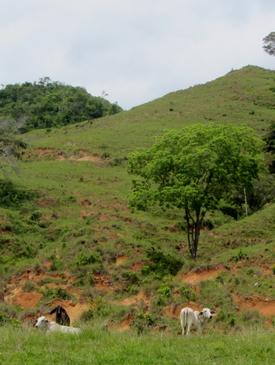Ecological Restoration Strategies for Cattle Ranching Landscapes of the Azuero
Summary
The tropical dry forest, the most endangered ecosystem in the tropics, is extremely threatened by the dominance of extensive cattle ranching. The consequences of conventional ranching systems in Panama are particularly severe in the dry forest ecosystem of the Azuero Peninsula. The destruction of forests has degraded the ecosystem service goods such as; water, soil fertility, and biodiversity, which are necessary to support ranching and agricultural livelihoods. With a low annual rainfall and a dry season lasting from five to six months, the region’s extreme climate variations compound the stresses of unsustainable land use practices and make efforts to restore the ecosystem particularly challenging. While advances in forest restoration and sustainable ranching have been shown to enhance production and ecosystem services in cattle ranching landscapes, they are virtually absent from the Panamanian landscape, mostly due to the lack of information and investment available to cattle ranchers. Therefore, ELTI has developed a field-based training course for cattle ranchers interested in learning about and implementing strategies to restore forest cover on their farm as a means to improve the provision and regulation of goods and ecosystem services and increase productivity on-farm.
Over a period of five days, this course aims to provide the practical basis to understand the importance of ecosystem services that originate from forests and how to implement forest restoration strategies in cattle ranching landscapes via silvopastoral system practices. This field-based course will be facilitated in ELTI’s Focal Training Sites in Azuero, which convey ecological principles through its interpretative trail network and demonstration sites. In addition, “farmer to farmer” learning is encouraged as participants are invited to observe the range of socio-economic contexts and associated restoration strategies through visits to model farms and discussions with their respective owners.
Content
Module 1. Basic forest ecology and ecosystem services
- Introduction to the ecosystem goods and services from forests
- Function of tropical dry forests
- Forest dynamics, succession and natural regeneration of tropical forests
Module 2. Land use and the forest degradation
- Regional drivers of degradation in Azuero
- Degradation of ecosystem services
- Socio-economic consequences of forest degradation
Module 3. Strategies for restoring ecosystem services in ranching landscapes
- Introduce the diagnostic methods of an area for potential restoration
- Clarify restoration goals and appropriate restoration models
- Methods for forest restoration (range of restoration options: Passive - Active)
Module 4. Sustainable ranching: An alternative to conventional ranching
- Biodiversity in agro-landscapes
- Introduction to silvopastoral systems (SPS)
- Factors to consider in implementing an SPS and alternative practices to restore forests in ranching landscapes
- Management and maintenance of a SPS
Module 5. Community organizations: Advancing ecological restoration via local leaders
- The need, development and dynamics of community-based associations
- Project development and identification of financing
- Project implementation and management
- Strategies for disseminating project information to the community
Module 6. Final exercise: Developing a farm management plan
- Objectives of land use planning
- Identifying biophysical and social variables
- Selecting adequate restoration strategies


